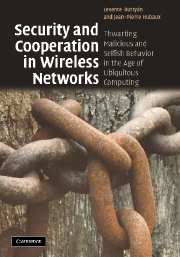 Security and Cooperation in Wireless Networks
Security and Cooperation in Wireless Networks Book contents
- Frontmatter
- Contents
- Preface
- Acknowledgements
- Part I Introduction
- 1 The security of existing wireless networks
- 2 Upcoming wireless networks and new challenges
- 3 Trust assumptions and adversary models
- Part II Thwarting malicious behavior
- Part III Thwarting selfish behavior
- Appendix A Introduction to cryptographic algorithms and protocols
- Appendix B A tutorial on game theory for wireless networks
- References
- Index
1 - The security of existing wireless networks
from Part I - Introduction
Published online by Cambridge University Press: 05 June 2012
- Frontmatter
- Contents
- Preface
- Acknowledgements
- Part I Introduction
- 1 The security of existing wireless networks
- 2 Upcoming wireless networks and new challenges
- 3 Trust assumptions and adversary models
- Part II Thwarting malicious behavior
- Part III Thwarting selfish behavior
- Appendix A Introduction to cryptographic algorithms and protocols
- Appendix B A tutorial on game theory for wireless networks
- References
- Index
Summary
Before discussing wireless networks, it is necessary to take a broad look at networking in general and to see why malicious and selfish behavior is such a relevant issue. For this purpose, we will consider the Internet.
The Internet is probably the most impressive achievement ever in networking: A simple set of brilliant engineering rules has led to the deployment of the most pervasive network that, in spite of its size (or rather, thanks to it), supports a growing number of services and applications. At the core of these rules stands of course the principle of universal connectivity.
Unfortunately, the Internet is plagued by several major problems, fuelled by this very principle. Viruses and spam have become a daily issue for most users around the world, many people fall prey to phishing attacks, and denial-of-service (DoS) attacks are routinely perpetrated against the servers of major corporations. An additional problem is that some network providers tend to establish walled gardens, by which they offer specific capabilities exclusively to their customers. Finally, some providers are tempted to interconnect their network in a way that is beneficial to themselves, but can be detrimental to the rest of the community. The situation is so critical that many prominent specialists, including some of the founding fathers of the Internet, call for a profound revamping of the network. Ambitious research projects, funded notably by the NSF and by the European Commission, have adopted a clean slate approach to respond to this challenge.
- Type
- Chapter
- Information
- Security and Cooperation in Wireless NetworksThwarting Malicious and Selfish Behavior in the Age of Ubiquitous Computing, pp. 3 - 32Publisher: Cambridge University PressPrint publication year: 2007


